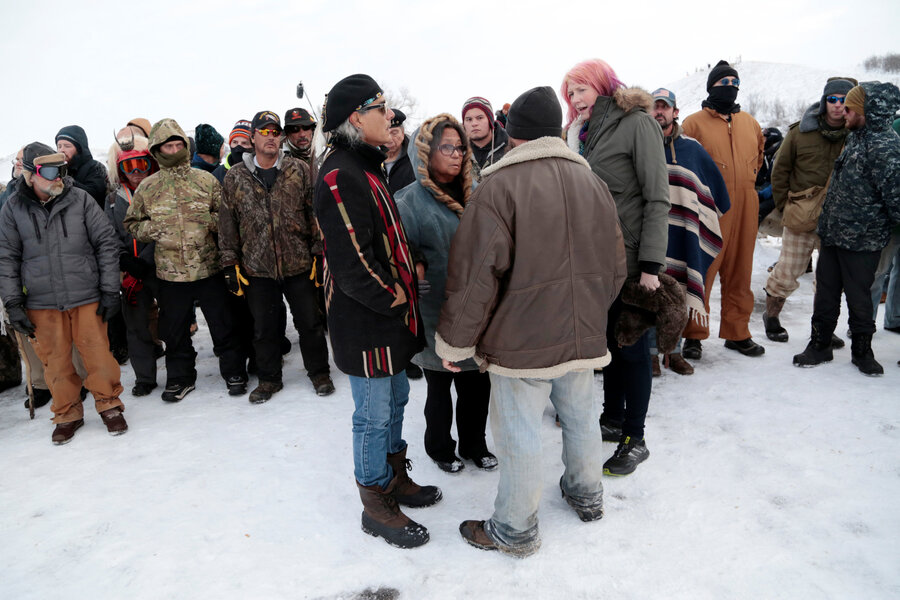The cavalry arrives: Veterans bring 'symbolic value' and support to Standing Rock
Loading...
With local authorities saying they will arrest protesters of the Dakota Access pipeline who refuse to leave federal lands by the end of Monday, hundreds of veterans are traveling to the Standing Rock Indian Reservation this weekend to join the self-described "water protectors."
Organizers with Veterans Stand for Standing Rock, the group behind the effort, says numbers could reach up to the 2,000-person cap they’ve set on attendance, and a crowdfunding drive launched by the group had garnered more than $990,000 of the $1.2 million goal by Saturday morning.
Widely regarded as a voice with special moral weight, the veterans hope to galvanize sympathy for demonstrators before the standoff comes to a head on Monday.
News of their participation gave a lift to the native American and other activists already there, notes Military.com.
"They are ecstatic," said Marine Corps veteran and group spokesman Anthony Diggs. "The support we're bringing is to sustain their operations out there in the freezing weather, and to create infrastructure and organization so when they need medical help, food, and warmth, they have access to it."
Mr. Diggs added that aside from supplies, lawyers, and healthcare professionals, their presence would bring “symbolic value.”
He said, "There is a lot of power in veterans from all over, from all branches of the military, coming together to create a protecting front against the police, who are militarized themselves."
Police have made several hundred arrests since August, and their crowd-dispersion tactics have drawn criticism from civil rights groups.
In one confrontation a few days before Thanksgiving, police used a water hose in sub-freezing temperatures against demonstrators. Police said the activists were trying to "flank and attack the law-enforcement line" to advance past a barricaded bridge to a pipeline construction site, according to the Washington Post. At least 17 people were hospitalized afterward, including some for hypothermia.
Civil rights activists have condemned the militarized police actions.
"We are concerned with numerous reports and testimony regarding the use of military-style equipment and excessive force against protesters," said a statement from the US Commission for Civil Rights, reported ABC.
"Our concerns are compounded by the disproportionate police use of excessive force against Native Americans, who are more likely than any other racial group to be killed by police."
State officials ordered the encampment vacated on Monday, citing the cold as a public safety concern, but they have continued to let vehicles into the site, according to USA Today. The Army Corps of Engineers has also cited "harsh North Dakota winter conditions" in its decision to close access to the site, but it says it won’t use force to remove people.
Protests of the crude oil pipeline started eight months ago by a handful natives, angered by what they see as the pipeline’s destruction of sacred sites and the potential contamination of the Missouri River, the tribe's water source. It has since transformed into a magnet for indigenous and climate activists, hosted on grounds with deep historical resonance for natives.
“The sodden grassy plains that now hold almost 1,000 protesters are saturated in the violent indigenous history – from the Sioux Wars of the late 19th century to the galvanizing but failed Wounded Knee occupation in 1973. Now, as this ground again becomes a focal point of solidarity, some here believe this protest is a turning point for both First Nations and the climate movement,” reported The Christian Science Monitor's Henry Gass in November.
"In its size, duration, and palpable urgency, some organizers believe the protest can pivot from being reactive to being proactive – from protesting something to building something.”
Attorney General Loretta Lynch released a video statement on Friday calling for "a peaceful resolution where all voices are heard" and pledging support for "the protesters’ constitutional right to free speech."
The veterans say their attendance will be non-violent.
"We will be unarmed, completely prepared for peaceful protest," Coast Guard veteran and group spokeswoman Ashleigh Jennifer Parker told USA Today. "We don't even like the word 'protest.' We're there to help the water protectors."






